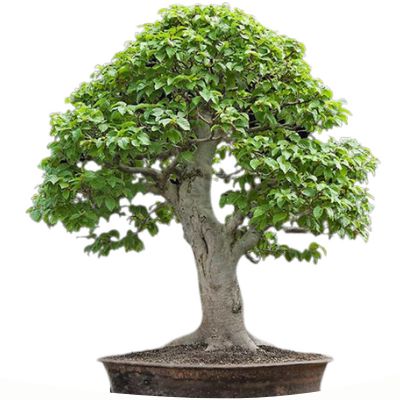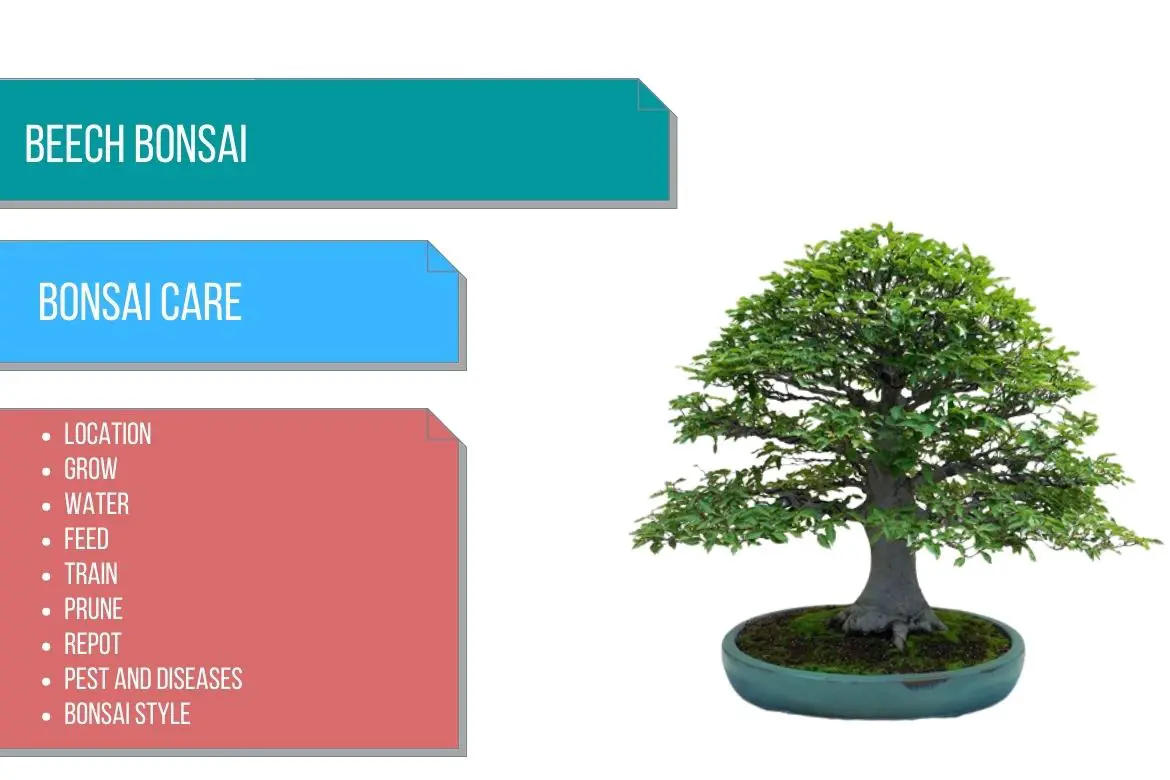
Beech
(Fagus)
Country of Origin : Japan
Bonsai Styles : Formal upright, informal upright, twin trunk, clump, group
Zone : 4 – 7
The beech tree is a large deciduous tree found throughout the northern hemisphere.
Despite the fact that all beech varieties can be trained into excellent bonsai, only two fagus species i.e. Japanese Fagus crenata and European Fagus sylvatica are commonly used to make bonsai.
For Beech bonsai tree, generally two species are used:
- Fagus crenata bonsai tree – Also known as Japanese beech tree or Japanese ‘white’ beech tree, these trees have small and delicate leaves with elegant “crimped” margins. Japanese beech variety has finer twigs and has a bark which will turn silvery white in color with age.
- Fagus sylvatica bonsai tree – Also known as European beech tree or common beech tree, these beech tree varieties have larger leaves. These leaves are pale green at first, however they turn dark green and eventually orangish-brown or yellow in color after which they fall in spring season. The color of the bark is greyish-brown.
In the single-trunk form, beech trees make fine bonsai; however, when planted in the group bonsai style, these trees make even better bonsai specimens.
It is fascinating to observe the enchanting transformation of the light green leaves of a bonsai beech forest as they turn yellow in fall, then turn bright copper during the winter, and finally fall just before the new buds open in spring.
It is natural for young beeches to retain their dead leaves in winter. By this, the buds are protected from snow and wind. Older trees lose this trait. However, in bonsai trees this tendency persists no matter how old or young the tree is.
Best location to keep Beech Bonsai
A native of Japan, Fagus crenata (zones 6-7) should be protected during extended periods of very cold weather in a frost-free greenhouse or shed.
A species of forest tree found throughout Central Europe, Fagus sylvatica is completely hardy (zone 4).
Nevertheless, with bonsai in general, there is no harm in moving the bonsai tree to a frost-free spot if you are unsure.
It is possible to grow both species of beech in full sun in summer as long as they do not dry out, however they will benefit from some shade during the heat of summer.
High heat will lead to the leaves becoming paler and the texture of the leaves will become ‘leathery’. This causes them to be less efficient at producing vital sugars for the tree.
As fall approaches, return the bonsai trees back to the sun.
The beech tree can tolerate freezing temperatures. When temperatures remain below 19°F (-7°C) for over a week, move the tree to a shed or a garage.
Many bonsai enthusiasts find that their plants need no shade by placing them in west-facing windows. Refer sunlight requirements for indoor plants for more indoor gardening ideas. Also, refer to do bonsai trees need sunlight for more indoor and outdoor bonsai location ideas.
Propagation of Beech
Beech tree can be propagated by using seeds. Fresh seeds should be sown in the fall, stratified seeds in the spring.
These trees can also be propagated by cuttings.
Watering Beech Bonsai
Beeches lose a lot of water through transpiration, so regular and abundant watering is necessary throughout the summer.
Reduce the frequency of watering the tree in winter. However, keep the bonsai soil moist.
Compost that is allowed to dry out will cause the leaves to wither and turn brown. Remove the dried leaves from the plant if this happens to encourage new growth.
On sunny days, avoid wetting beech foliage as it scorches easily.
Wiring Beech Bonsai
When beech tree bonsai branches are wire-trained, they set quickly.
In most cases, beech bonsai trees are shaped by pruning, however if wiring is needed we can do it between spring and autumn.
Japanese Beech tree’s bark is such an attractive feature that it should be protected with raffia before the wire is applied.
At the end of the summer, remove the wires.
Pruning Beech Bonsai
When to prune Beech bonsai?
How to prune Beech bonsai?
Pruning of beech bonsai tree can be done in late winter or early spring. It can also be done three weeks after or before repotting. Pruning wounds heal rapidly in beech tree.
Mid-summer pruning will encourage rapid regeneration from the wound area.
As soon as new shoots begin to darken in color, they should be pruned back to one or two leaves in order to promote more branching and finer twigs.
After following this routine for a few years, the twigs will create a beautiful tracery in winter – provided you can manage to remove the copper-colored leaves.
In order to see the branch structure, prune in the spring before the leaves emerge if you notice that the twig structure has become very dense.
Removing all leaves is not recommended. Although beech will quickly grow new leaves after defoliation, they are completely different from the original leaves. Their shape is flatter, rounder, and twisted. These leaves are unsightly.
During the growing season, only remove unusual large leaves.
Pinching Beech Bonsai
Immediately after two true leaves have begun to harden, pinch out the growing tips.
In weak areas, shoots can be allowed to grow up to six or seven leaves, then cut back to two leaves.
Repotting Beech Bonsai
When to repot Beech bonsai?
Young beech bonsai tree can be repotted in early spring every two to three years. However, when the beech bonsai tree becomes ten or so years old, you can repot the bonsai tree whenever the roots become pot bound.
The bonsai tree can also be repotted in late winter or fall as long as it is kept frost-free until spring, a minimum of 28°F (-2°C).
Beech trees are tolerant to a variety of soil types as long as the soil is not waterlogged.
You can use a basic soil mix.
OR
You can use akadama. If you are using Akadama, be extra careful when watering during the first three months when the roots are establishing.
OR
You can also use a bonsai soil which is a mix of sand and loam in the ratio of 1:1.
Must Read: Bonsai Soil Recipes
Must read : Choosing the right bonsai container
Feeding Beech Bonsai
Between late spring and midsummer, use a balanced feed.
From late summer until the leaves turn yellow, use a nitrogen-free feed.
Wait three to four weeks after the buds have opened before applying the first spring feed.
Diseases and pest of Beech Bonsai
Beech bonsai trees can be infested by aphids. These aphids damage the shoots and also produce a sticky ‘honeydew’. This sticky substance can discolor the tree’s foliage and also carry fungal spores.
These trees can also be infested by leaf eating insects and scale insects.
A systemic insecticide can be used to treat aphids and scale insects that attack beech trees.
Poor ventilation can lead to powdery mildew in a beech bonsai tree.
Beech bonsai care
When exposed to drying winds and strong sunlight or dry soil, beech leaves scorch easily and become pale and ineffective. Beech trees in bonsai pots are unable to tolerate these conditions, so they must always be protected from wind and sunlight.
It is not necessary to water a tree more heavily to remedy this, but to shelter it from harsh conditions.
As water droplets act as tiny magnifying glasses, they will also cause localized scorching if they are allowed to remain on leaves in hot sunlight.
Die-back can also occur on the branches if they do not receive enough light. You should prune the branches to healthy tissue if it occurs.
What to look for when buying Beech Bonsai
When you purchase your bonsai beech tree, it will probably have many thin branches. These thin branches need to be cut back so that the remaining primary branches can be trained with wire and allowed to grow and thicken.
Most beech trees are propagated from cuttings, and some smaller bonsai are potted up before their roots have fully developed. Hence, examine the roots to ensure they are firmly anchoring the bonsai tree to the bonsai container.
If you are buying a group or forest planting bonsai style, take a closer look at the composition. Ensure that there are trunks of varying thickness, with the largest and thickest trunks at the front and center.
To create the illusion of perspective, the other trunks should be thinner and become shorter at the back and the sides.

